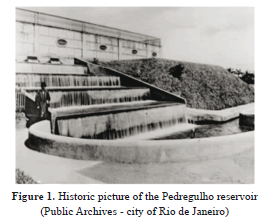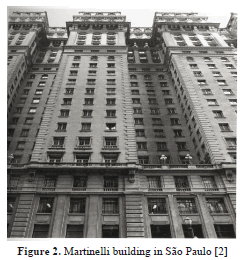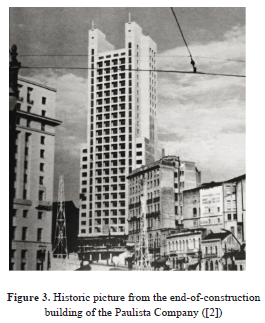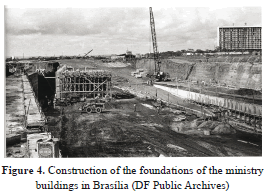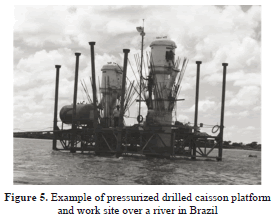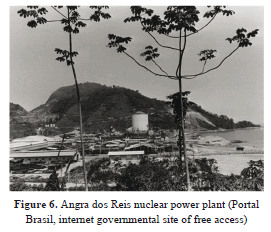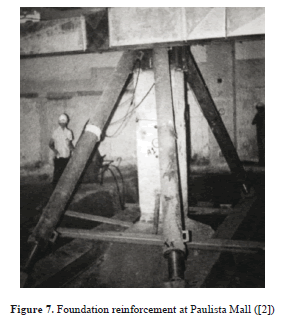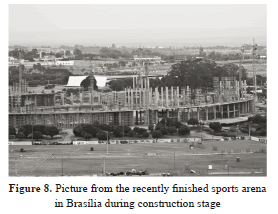Services on Demand
Journal
Article
Indicators
-
 Cited by SciELO
Cited by SciELO -
 Access statistics
Access statistics
Related links
-
 Cited by Google
Cited by Google -
 Similars in
SciELO
Similars in
SciELO -
 Similars in Google
Similars in Google
Share
DYNA
Print version ISSN 0012-7353
Dyna rev.fac.nac.minas vol.81 no.183 Medellín Jan./Feb. 2014
https://doi.org/10.15446/dyna.v81n183.31435
http://dx.doi.org/10.15446/dyna.v81n183.31435
ADVANCE OF FOUNDATION TECHNIQUES IN BRAZIL SINCE COLONIAL TIMES
PROGRESO DE TÉCNICAS DE CIMENTACIÓN EN BRASIL DESDE EL TIEMPO COLONIAL
RENATO P. CUNHA
Profesor Asociado, Ing. Civil, Ph.D., Universidad de Brasilia, Brasilia, Brasil, rpcunha@unb.br
PAULO J. R. ALBUQUERQUE
Profesor Asociado, Ing. Civil, D.Sc., Universidad Estadual de Campinas, Campinas, Brasil, pjra@fec.unicamp.br
Received for review August 1th, 2012, accepted June 19th, 2013, final version July, 2th, 2013
ABSTRACT: This paper presents a summary of the historical developments on foundation engineering that took place in Brazil since its early beginning until the present time. It relies on published information pinpointed from historical and reference books widely available today that were, on the other hand, written with basis on oral and written recounts and documents that survived through time. The intention is not to present a detailed discussion on the subject, but rather illustrate how, in common terms, foundation engineering technologies (and challenges) have been improved and approached throughout history in Brazil - shedding light as to what may be expected in this field for the near future of the new millennium.
Key words: History of foundations, usual foundation types, foundation techniques
RESUMEN: Este artículo presenta un resumen del desarrollo histórico que ocurrió en Brasil desde su principio hasta el tiempo presente. Está basado en información publicada y sintetizada de libros históricos y de referencia ampliamente disponibles actualmente que fueron, por otro lado, escritos con base en relatos orales y escritos y documentos que sobrevivieron a través del tiempo. No se tiene la intención de presentar una discusión detallada acerca del asunto, pero de ilustrar como, en términos generales, las tecnologías de la ingeniería de cimentaciones (y sus retos) fueron mejoradas y tratadas durante la historia de Brasil - reluciendo lo que se podrá esperar en este campo para el futuro inmediato del nuevo milenio.
Palabras clave: Historia de las cimentaciones, tipos usuales de cimentación, técnicas de fundación
1. INTRODUCTION
With the necessity of urban development, and the evolution of civil engineering, allied to nowadays a high level of demand for the construction of structures with increasingly slender and heavier buildings, foundation engineering in Brazil has advanced considerably since its early beginning.
In addition to the structural elements of the project, another recent factor of extreme importance for the development of the techniques for foundation execution and design is the limited (or lack of) urban space and the choice of location for new constructions in a quickly developing country. In many cities another aspect took place, i.e., previously disregarded regions of the "Brazilian continent" began to be populated and this fact imposed technical difficulties that necessarily needed to be overcome.
Therefore, the history of the foundation engineering in Brazil is briefly presented herein, concentrating on its most developed and populated cities, Rio de Janeiro and São Paulo (and surroundings). It does not intend to be a state of the art on the subject, but rather highlight the most interesting and relevant points in this evolution of design and construction techniques. Within this scope, as will be shown, some historical cases are emphasized together with the main techniques that have been employed in the country since the colonial times.
It shall be pointed out that the presented data comes from a compilation (and sometimes modified translation) of information submitted in the chapter 1 of a renowned book published in Brazil by the Soil Mechanics Society [1], combined with pertinent passages from another recently published book on the "History of Geotechnical Engineering in Brazil" [2]. Hence, the paper summarizes aforementioned data to fulfill a broader information scope directed towards the international audience.
2. HISTORICAL DEVELOPMENTS
2.1. Colonial period (XV-XVIIIth. centuries)
In the colonial period of the XVI century, around 1530, the buildings could be classified into three groups according to the reference [3]. The first group corresponded to works/factories associated with the sugar industry and exporting port facilities, whereas in the second group one could find military buildings like forts and barracks, plus churches, monasteries, public buildings and related commercial chains, and finally the third group is comprised of civil works and houses of any dimensions plus business stores, warehouses, flour mills and so on. According to this reference, there are only a few reports on the foundation characteristics of these buildings, being possible to confirm a common knowledge that, since such remote period, foundations were made of excavated trenches filled in with "compacted" stones.
Around the XVII century, in the range of 1684, the reference [4] states that for the construction of the Monastery of St. Benedict, in the city of Rio de Janeiro, a "Statement of Construction" was written which contained specifications for the construction of the monastery. In one of the items presented by the document, one can find the techniques for the construction of the base foundation. In this statement the author demonstrates that concepts of "tension" and "resistance of the material' were already known at the time, being associated with the need of reaching a foundation level where a subsoil material of sufficient hardness to support the superstructure building exists. This document also mentioned that the presence of water in the subsoil could ruin the trenches excavated for the construction of this particular foundation.
Unfortunately the available information of this period is rather limited and further knowledge would require a more ample and thorough research, which could not be done.
2.2. Monarchic period (XIXth. century)
The monarchic period lasted around 1 century, and by its mid course, in the range of 1850, Brazil was ruled by an aristocratic and conservative society, driven by an agricultural economy that depended exclusively on slave labor. This was the period in which the coffee culture granted economic stability to the empire, allowing some few entrepreneurs, like Mr. Irineu Evangelista de Sousa, or the Baron de Mauá, to open a bank and to give financial incentives to large and diversified private enterprises, as, for example, the construction of the first Brazilian railway in Rio de Janeiro. The construction of this railroad was an impressive achievement for the time, since this construction was made up of bridges and tunnels, the largest of which with over 2000 meters in span. There are unfortunately few reports on the foundations of such bridges, nonetheless such engineering work can be highlighted as a true benchmark for the geotechnical engineering in Brazil. From then on, many other railroads and associated engineering works were built along the vast domains of the empire.
At the same time the construction of civil houses began to use panels made of bricks attached to beams and iron columns, due to the collapse of existing constructions built solely on "taipa" (which is a constructive technique imported from the Portuguese colonizers, still used nowadays in the poor inner rural areas of Brazil, based on the manual compaction of a mixture of local soil, predominantly clayey type, plus water and gravel).
Since then, the construction of industrial buildings, markets, warehouses, railway stations and associated works, such as the "Light Station" in São Paulo emerged. This construction, among others erected between 1884 and 1896 in the cities of São Paulo, Rio de Janeiro, Recife and Manaus, included the use of imported bricks, steel structural elements, and a metal roof. In view of such developments, particularly in the structural field, it became also necessary to leverage and improve current construction (and design) techniques for the foundations. The trenches filled with "compacted" stones were soon replaced by shallow foundations, strip foundations, or rigid blocks of brick masonry or carved rock, manually laid down at foundation base and compacted inside the ditches. According to reference [5], in the late XIX century, after the installation of the first engineering schools in the country, witnesses could observe that the Brazilian civil engineers held some understanding of the "technology of soil".
It is worthy to mention the interesting case of the water reservoirs from the Pedregulho station in Rio de Janeiro (Figure 1), where two tanks were constructed to store water for this (expanding) city, one upstream of the other with a differential topographic level of 5 meters.
After several days of tropical rain, the lower reservoir built near the slope base, had several cracks in the walls and had to be immediately emptied. According to [6], formal transcripts exist of a meeting dated July 12, 1880, i.e., over two months after the construction of the reservoir. The records reveal that the engineer Honório Bicalho (well known in Brazil) diagnosed the cause of the accident as due to differential settlements that were produced by "the lack of homogeneity of the terrain, related to the decomposition of the primitive rock, gneiss, which originated a residual soil of compressible and collapsible characteristics".
During the nineteenth century the interest in mining works, particularly iron mining, started to gain strength in Brazil. From then on, it started a large demand for geological surveys in such related works, and a close relationship between geology and (geotechnical) civil engineering was established in the country. Then, in 1907, the "Engineering Geology" field of expertise was initiated, whose early works lie in the geological survey for the implementation of railways and roads. Engineering geology also significantly contributed at such a time (as of present) to the development and implementation of the projects of the foundations of embankments and dams, or the special art works (bridges, tunnels) of road/railway constructions.
With the expansion of the empire, enlargement of the cities and population growth, and associated natural evolution of the engineering problems, new challenges emerged by the mid to the final period of this century. Many problems were related to pier foundations designed for the construction of ports, in regions comprised of geologically characterized quaternary deposits, that means with a high frequency of sedimentary saturated layers of soft soil materials.
It is also reported that even though wooden piles were known and openly used at such time (as for "classical" example the Municipal Theater of Rio de Janeiro, erected in the early XX century), the lack of knowledge on the behavior of the subsoil, allied to the inexistence of settlement control techniques, led local contractors to avoid constructing new buildings in areas of soft deposits. On the other hand, it was precisely the construction of a foundation comprised of timber piles, driven by an innovative (for the time) steam powered hammer, which promoted the successful construction of deep foundations on such coastal sedimentary strata. The particular case of the design and construction of the Customs Docks in Rio de Janeiro, which started in 1866, is an example of that.
2.3. XXth century
In the early twentieth century the designers and contractors started to count with one of the best construction materials of the modern civil engineering industry: Reinforced concrete. It was known that concrete multi layer structures of this era could be built over shallow footings of reinforced concrete or on top of massive rigid blocks of non reinforced concrete. Besides, deep foundations could be represented by reinforced concrete types in addition to the wooden ones already in use. This era was also initially marked by the entry in the market of the first specialized company of seaport construction and pile foundations in Rio de Janeiro, and by the expansion of the port of Santos, where the first reinforced concrete pier supported by concrete piles and retained by a sheetpiling wall was constructed. Between 1926 and 1927 the dock of Rio de Janeiro was also expanded and the foundations consisted of pressurized piers made with driven shaft elements of reinforced concrete.
However, until the end of the '20s, empiricism was predominant in geotechnical engineering. "Experimentation, however little, was carried out directly in the stonemasonry of the work and in a restrained fashion", according to the former ABMS president, the engineer, Antonio Nápoles Neto, in a lecture given in 1970 [2].
Possibly the first Brazilian geotechnical undertaking was described by Domingos da Silva Cunha in the Brazilian Journal of Engineering (1920) with the title "Experiments on terrain for the study of foundations". In this paper, this author warned of the variations in resistance and deformation of the soil as a function of chemical content, variations in the terrain's humidity and depth.
Nevertheless, it was precisely in the next decade that the first academic investigations were carried out by technological research institutes of the young Republic, and by the Polytechnic School of São Paulo (USP), the latter one more focused on the particular problems of foundation engineering. In 1934, the Laboratory for Material Testing of the city of São Paulo was transformed into the Institute of Technological Research of São Paulo (IPT), attached to the academic activities of the Polytechnic School. Early work in IPT started in 1938 under the coordination of engineer Odair Grillo (well known in Brazil) and aimed both the correct paving of earth roads and the study of foundations of bridges and buildings. In regard to foundation engineering, which is the scope of this paper, the first step to solving engineering problems was the development in 1939 [6] of a drilling/sounding equipment for the exploration and analysis of the subsoil. Thus, IPT standardized a soil exploratory device method, later published by Vargas (1945), which consisted of the introduction of a standard thin walled steel sampler by a percussion method with water circulation, simultaneously to the counting of the required number of strokes of a falling impact hammer of 60kg in weight, from a gravity drop height of 75cm. The number of blows necessary to penetrate this sampler to a standard length of 1 feet (30 cm) was termed as N(IPT). Besides this particular number, another standard was created by a private company for research and project in soils and foundations. This latter one also started to be largely adopted in the country, with a distinctive nomenclature of N(MG). Subsequently, the reference [7] suggested in 1948 the worldwide method commonly practiced today, known as Standard Penetration Test (SPT), with its corresponding N(SPT) number. The high variability of the testing results from both "Brazilian" techniques at the time, given differences in procedure and especially due to distinct "standard" N quantifications, posed serious problems of comparison and foundation design (via empirical rules, as still used nowadays). Therefore, over time, persuaded by regular discussions on technical congresses, the IPT´s number N variable was replaced by the international SPT quantification method of reference [7], this approach was later regulated and standardized for the whole country by the Brazilian normative NBR 6484 in its first version of 1980.
Among the numerous construction sites and foundation works carried out in the country during the 20th century, some are worth mentioning and deserve to be described, especially given their innovative solutions adopted and the engineering difficulties they faced with the available technology at the time.
A first case that deserves mention in the city of São Paulo, around 1925, is the construction of the first skyscraper in Latin America, the Martinelli building (Figure 2). The foundations were laid down using wooden piles and spread footings up to 16 m depth. It required lowering the water level, which resulted in structural damage to a neighboring building, leading to a temporary suspension of the work. The 25 storey, reinforced concrete MartineIli skyscraper was considered the highest in the world at the time.
Another case was the construction of the foundations of the State Bank Building. It shall be initially mentioned that, given the experience coming from previous geotechnical investigation campaigns in São Paulo, designers and contractors already had some knowledge beyond the local geotechnical parameters, i.e., they could also anticipate in some way the foundation behavior of the common buildings in the region. Nevertheless, in the present case, the construction process of the piles of this building encompassed the dynamic penetration of closed end tubes through a stiff clay stratum. This execution feature caused the lifting of the surrounding ground level by values around 70cm, leading to breakage of surrounding piles that had been (previously) molded in place. It was observed by load tests carried out in the site that such piles had compressive bearing capacities as low as 30% of the expected values. The problem was then solved by the installation of additional piles, summing up to a total of 400 piles in this particular work, all of them partially excavated around the shaft after the casting period to prevent damage during the driven stage of the new piles.
Another example that also deserves mention is the case of the Building of the Paulista Insurance Company in São Paulo. This is a 26 storey building that began construction in 1940, and in which the investigation of the subsoil was partially conducted inside the construction area given the existence of an old building that was about to be demolished (during further construction stages). Thus, the piles were designed based solely on one of the sides of the site, which allowed those foundations to behave as end bearing due to an existing shallow stiff clay stratum. However, it happened that on the other (non surveyed) side existed a layer of soft silt. This misconception in design was further aggravated by the (satisfactory) load tests solely carried out on piles that were installed on the investigated side. After three years, in 1943, the building was opened and soon afterwards, the IPT Institute detected in the monitoring records an accelerating tendency of column settlements from the building side located in the non investigated part of the site. Daily differences, or settlement increases of up to 1mm from morning to afternoon readings, were noticed, together with a steadily tilting of the building. This edification is presented in Figure 3.
According to what was presented by reference [8], the solution of the problem was achieved by an overall freezing process of the subsoil in 162 freezing steps, in which the final temperature was kept at -20° Celsius. It was followed by the drilling of injections wells, where galvanized metallic pipes were installed up to 14m in length. With the hardened ground and transitory suspension of settlements, injection of concrete was carried out through these pipes, transforming them into cast-in-situ reinforcement piles. The building was finally realigned in the vertical direction by the temporary insertion and pumping of hydraulic jacks onto existing columns.
Still around the '40s two other studies conducted by the IPT stand out. One of them is related to the foundations of the bridge over the Rio Grande river during the construction of the railway Corumbá-Santa Cruz de la Sierra (in Bolivia), which crossed a terrain filled with "quicksands" and swelling clays. The other one refers to the design of the foundations of the Steel plant in Volta Redonda, where for the first time foundation problems associated with soils derived from rock alteration, or saprolites was noticed [9].
In the '50s, and with continuing studies of the previous decade, both IPT and the private company Geotécnica SA monitored the settlements in tall buildings founded on shallow foundations at the coastal zone of Santos, an area typically known (later on) by its thick layers of saturated soft clays. The results of the investigation in Santos were henceforth published by references [10], [11] and [12], by reference [13] and by reference [14], the latter ones related to the settlement of foundations over soft sand deposits. Given such experience, reference [15] presented arguments and conclusions about the Brazilian expertise in forecasting and monitoring the settlements in buildings, during the state-of-art of an international conference on Soil Mechanics in 1977.
Within this same decade, the project of the Guaíba river crossing in Rio Grande do Sul deserves a special note, as this project highlights the use of bridges founded on deep foundations of the Franki type with relatively long lengths. In Rio de Janeiro the project and construction of the building Marquês de Herval, conducted by Prof. Costa Nunes (well known internationally), also calls for attention. This building was constructed by subsoil excavation with the simultaneous water level drawdown down to as much as 9 meters deep, in a region surrounded by older constructions founded on shallow foundations.
It was also in the '50s that the construction of today's capital of the Federative Republic of Brazil, the city of Brasilia, had started. Figure 4 presents a photo of the construction phase of the ministry buildings in 1959, in the heart of the new city. Companies from the Brazilian capital (at the time), Rio de Janeiro, were responsible for conducting the site investigation of the subsoil, which is composed of sandstones and siltstones covered by a layer of residual soil, originated from the same typical metamorphic type rocks of the region. Faced with such distinctive geological conditions (from the coastal zone), the contractors opted for deep foundations with Franki type piles and uncased manually excavated caissons.
Later on in Rio de Janeiro, between 1960 and 1964, the Duque de Caxias oil refinery was built by employing several types of deep foundations, among them pressurized drilled caissons, which led to a total length that exceeded 400km of piles. Other relevant information of this work is the consumption of concrete and steel that reached 120 cubic meters and 10 tons (100 kN) respectively. Since then, one could affirm that the foundation engineering was finally consolidated in the country.
In 1963, the José Bonifácio steel plant, belonging to the Paulista Steel Group (Cosipa) was inaugurated close to Santos. The region is characterized by the presence of wetlands with soft clay deposits at surface extending to up to 25 m in depth. Faced with such geological conditions the solution by shallow foundations proved to be unattainable, allowing the exclusive use of deep foundations which totaled 110 thousand piles varying from centrifuged precast concrete types, metallic H shaped piles and mixed (composite) piles. The main problems encountered in implementing the foundations of the plant were the execution of the jointing sections of the long piles, the enhanced corrosion by the marine environment, the excess pore pressures generated during the dynamic insertion of the piles and negative friction between the shaft and the surrounding soft clay by consolidation phenomena. To understand and manage the behavior of the foundations, the IPT conducted over 300 pile load tests at this site.
Still in the '60s, the construction of the highway Piaçaguera-Guarujá, now known as Cônego Domênico Rangoni, had started close to Santos. About 12km of the road lies in a region of very soft organic soils of up to 40 meters in thickness. Six bridges were required to be built in this highway, with particular emphasis on the one crossing the Bertioga channel, that required 8 pressurized drilled caissons in the central span and dozens of metallic piles, with varying lengths from 10 to 60m on the edges. The road was opened in 1970 as a result of the implementation of pioneering techniques of geotechnical engineering.
The '70s was marked by several works of great technical challenge and financial impact for the country, taking advantage of the good winds in which Brazil was sailing on at the time (nowadays recalled as the "economic miracle" era). Among several works it is highlighted the Transamazônica highway (1972) through the rainforest, The Lagoa-Barra highway (1971), the Steel railway (1973), the Immigrants highway (1976), the undergrounds in both Rio de Janeiro and São Paulo, and some of the astonishing in size, for the time, hydroelectric power plants (Itaipú, Tucuruí) that still serve the country nowadays.
Regarding the work of foundations, the literature highlights the Rio-Niterói Bridge (1974), where a tragic accident took place during a load test over the Guanabara Bay, causing the death of two workers. This bridge is 13.3km long and 26.6m wide, with six lanes of traffic, and is still considered nowadays a national landmark of engineering, given all the executive difficulties and the geotechnical particularities. As for the bridge foundations themselves, in the dry (land) sections metallic and Franki piles were used, whereas in the wet (sea) section pressurized 1.8m diameter drilled caissons were constructed with lengths that varied according to the thickness of the superficial organic soft clay of the bay. This was considered a pioneer solution for the time. Altogether 1138 caissons were built, of these 462 were pressurized by air, 199 were of mixed type and 477 used the "Bade-Wirth" technology. The pressurized caissons with enlarged base (similar example in Figure 5) were adopted whenever it was possible to support them in the sedimentary compacted sandy stratum located underneath the soft clay, up to a total length of 30 meters.
The mixed caisson types were built with the dynamic insertion of a steel pile into a young residual soil and the subsequent submerged concrete molding of the caisson's shaft. Finally, the Bade-Wirth types were founded on rock and were mechanically drilled with the support of a metallic shaft, following the subsequent structural reinforcement with a steel cage that was lowered down just before the final molding stage.
The '80s began with works of great impact that in the vast majority have been started in the preceding decade. As key examples one can recall the first nuclear power plant in Brazil, whose construction started in 1970 (Angra dos Reis 1 - Figure 6) and the conclusion of the hydroelectric power plants. This decade is also marked by the construction of the Carajás railroad, the expansion of the Rio de Janeiro international Airport of Galeão (also known by Tom Jobim airport) and the construction of the international Airport of Guarulhos in São Paulo.
In 1982 the Port of Sepetiba in Itaguaí was opened, renamed in 2006 to Port of Itaguaí. The region of the implementation of the port has a subsoil typically composed by an organic silty clay of high compressibility and low bearing resistance, with thicknesses of up to 12 meters. Large diameter long piles were designed and implemented for the storage yard of the port, and the final solution also encompassed the dredging of the soft clay layer and its replacement by a hydraulically compacted sandy fill.
In the '90s the magnificence of the Brazilian economy slowed down, given international external problems, as the "petrol crises", and national internal financial calamities, such as hyperinflation and recession (nowadays known as the "lost era"). Nevertheless some milestone works can be recalled upon, such as the excavation and foundation reinforcement of the Sears store in São Paulo in 1989, to what would later be known as the Paulista Shopping Center. Located in an area of large commercial appeal and high acquisitive economic power, this work was marked by its great difficulty (see some of the few remaining pictures on Figure 7).
The original conception was the deployment of three additional basements to the original Sears Mall, built in 1949. It is reported that the original building consisted of three floors and a basement with a level difference of 4.3 m to the street. The first building block had shallow foundations founded at 2 meters below the basement level, and the second block was supported by drilled caissons of 14 meters long, which were constructed in 1972 during the initial expansion project of this mall.
The foundation solution adopted for the first building block was the substitution of the shallow foundations to deep ones, allowing the excavation of an extra 9 meters of soil, for the 3 additional required basements. For the second block, the strategy was the simultaneous reinforcement of the existing caissons along with the excavation. At the end, the caisson's bases were enlarged and concreted with additional steel reinforcement cages. Besides of the foundations, retaining structures made of (secant and non secant) pile curtain walls with caissons of enlarged (and non enlarged) bases were constructed to safely sustain the excavation process. It is worthy to mention that the commercial activities of the Sears Mall were not interrupted during the execution of such services.
2.4. XXIst century - new millennium
Similar to the readjusting tides, so are the economies of the world. After an era of depression and internal readjustments, which painfully demanded many personal sacrifices, political compromises and a new economic order, Brazil was able to turn over the table and reestablish itself in the path of sustained development and growth. Being part of what is called nowadays the BRICS group, the engineering possibilities, challenges and achievements for the new millennium are undoubtedly broad and large, as well as the encouraging mood and optimistic feeling of the people inside and outside the country. The coming Football World Cup event (in 2014) and the Olympic Games (in 2016) have called the attention for a general readjustment of key urban elements, such as transportation, airports, housing, hotel and entertainment venues, energy, security and, of course, stadiums and sport arenas of several types (for instance, see Figure 8).
Therefore, among the various geotechnical works which debuted together with the starting millennium, one shall highlight the full renovation of the (tilted) buildings in Santos, the expansion of the Porto Alegre airport, the conclusion of the express South highway of Florianópolis, the construction of the piled embankment of the SESC, close to the future installations of the Olympic villa in Rio de Janeiro and the diverting beltway (ring road) around São Paulo.
Also, it is worthy to mention the constructions of refineries and pipelines in the northeastern and northern regions of Brazil, the expansion of the petrol industry by the discovery of unknown "pre-salt" oil basin in the southeast region, the renovation and construction of new sport arenas throughout the 12 base cities of the coming World Cup, and the (fast growing) residential urban expansion of interior cities all over the country, among other things.
The fast development of the country involves not only the use of more sophisticated techniques for foundations to support the increasing magnitude of the loads from superstructures that become more slender and tall everyday, but it also involves the formation of a skilled work force to safely deal with, the design and construction of such demanding structures. This point is valid for all fields of engineering, from foundation, to civil, mechanical, electrical, naval, energy and so on. Besides, the increasing demand for sustainable construction, space optimization and green areas have obliged urban constructions to use "less noble" subsoil areas for parking, transportation, storage and related items, leaving open environments for the more noble activities of living, entertaining and working. Besides, and regarding safety, the Brazilian standard obliges the execution of pile load tests in deep foundation projects with more than 100 piles. Such experimental validation must be done in even larger numbers in South America in order to advance the knowledge of this field throughout distinct soil sites [16].
Therefore, there is a potential challenge to develop and sustain an increasing demand for technologies capable of producing deep foundations with longer, slender and vibration/noise free piles, that would cause minimal intervention and disruption to the surrounding environment, and would eliminate the production of undesirable (environmentally unfriendly) by-products, such as contaminated soil, soil-bentonite mixtures, etc. It is with such spirit that one must realize that the foundation engineers of the future (those who are still working or studying today) will face a new reality in which the foundation problems will be engaged and solved altogether with other perspectives, i.e., from the geological and geotechnical point of view to the environmental restrictions, special construction characteristics, optimization procedures, and for sure the mandatory sustainable attitudes of the new age (as so well recognized in the recent international Conference "Rio+20" held in Brazil).
3. CONCLUSIONS
Despite the fact of being one of the South American countries that got independence from the colonial power at a later stage (1822), Brazil was able to accompany and even surpass the urban development of some of its neighbors.
The continuing investment in new machines and technology, the formation of a skilled work force at distinct levels (from technicians to Ph.D. Professors), the appreciation of the high education value, the national and international outsourcing of exceptional professionals, the free exchange of knowledge between multi-level institutions, and the urgent reconfiguration of many of the outdated Brazilian standards are some of the challenges for the future.
REFERENCES
[1] ABMS. Foundations: Theory and Practice. 2nd edition, PINI Editors, São Paulo. 751p, 1996. (In Portuguese). [ Links ] [2] Sayão, A., History of Geotechnical Engineering in Brazil. 60 years of the Brazilian Association of Soil Mechanics and Geotechnical Eng. ABMS Ed., São Paulo, P. 252, 2010. [ Links ] [3] Katinsky, J.R., Colonial Construction systems. History of Technique and Technology in Brazil. UNESP. CEETEPS, São Paulo, (In Portuguese), 1994. [ Links ] [4] Silva Nigra, D. and Clemente, M., Three Benedictine artists. Typography. Ministry of Education and Culture. Salvador, (In Portuguese), 1950. [ Links ] [5] Grillo, O., The Soil Mechanics at the Technical Road. Bulletin of the DER. Year V, Vol. 5, No. 4. São Paulo, (In Portuguese), 1939. [ Links ] [6] Vargas, M., Exploring the Underground for the Purpose of Civil Engineering. Publication No. 242. Year 41, No. 149, October. Technology Research Institute (IPT), São Paulo, (In Portuguese), 1945. [ Links ] [7] Terzaghi, K. and Peck, R.B., Soil Mechanics in Engineering Practice, John Wiley and Sons, New Cork, 1948. [ Links ] [8] Villares, A., The Underpining of the 26 story Building Cia de Seguros - Sao Paulo, Brazil. Geotechnique, Vol. 6, Issue 1, March, pp. 1-14. 1956. [ Links ] [9] Nápoles Neto, A.D.F and Lorraine, P., The Foundations of the plant at Volta Redonda. Publication No. 539. Technology Research Institute (IPT), São Paulo, (In Portuguese), 1956. [ Links ] [10] Teixeira, A.H., Case History of Building underlain by Preconsolidated Unusual Condition of Clay Layer. Proceedings of 1st Panam. Conf. Soil Mechanics. Mexico, 1959. [ Links ] [11] Teixeira, A.H., Contribution to the study of the Time-Settlement Relation of Actual Structures. Proceedings of 1st Panam. Conf. Soil Mechanics. Mexico, 1959. [ Links ] [12] Teixeira, A.H., Typical subsoil conditions and settlement Problems In Santos, Brazi. Proceedings of 1st Panam. Conf. Soil Mechanics. Mexico, 1959. [ Links ] [13] Machado, J., Settlement of Structures in the City of Santos, Brazil. Proceedings 5 th Int. Conf. Soil Mech. and Found. Eng., Paris, 1961. [ Links ] [14] Vargas, M., Foundations of Tall Building on Sand in Sao Paulo, Brazil. Proceedings of the 5th International Conference on Soil Mechanics and Foundation Engineering, Paris, 1961. [ Links ] [15] Burland, J. B., Broms, B. B. and de Mello, V. F. B., Behavior of foundations and structures. State of Art Report. Proceedings of the 9th International Conference on Soil Mechanics and Foundation Engineering, Tokyo, Vol. 2, pp. 495-546, 1977. [ Links ] [16] Valencia, Y., Camapum, J. y Lara, L., Aplicaciones adicionales de los resultados de pruebas de carga estáticas em el diseño geotécnico de cimentaciones. DYNA, n.175, pp.182-190. 2012. [ Links ]













